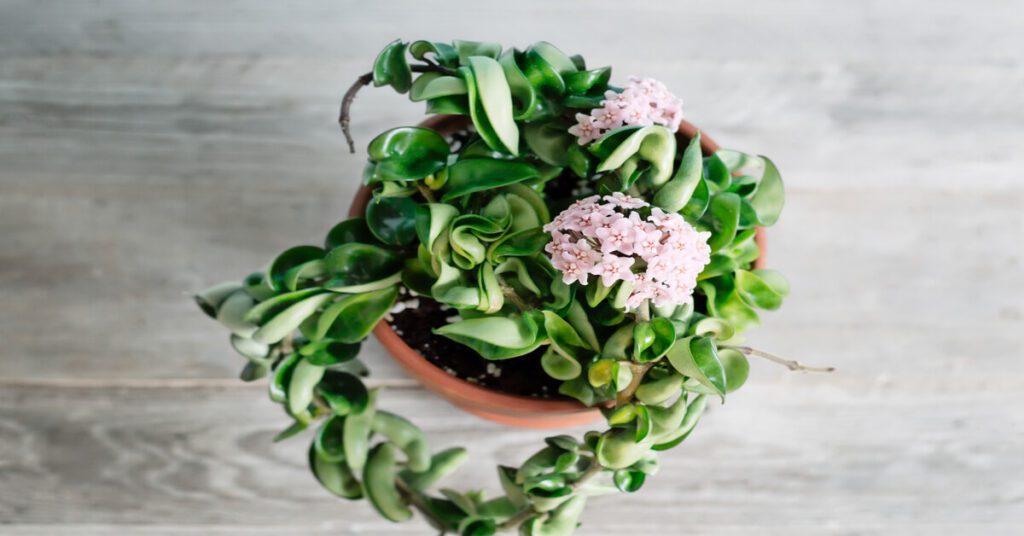Nicknamed the Hoya Hindu Rope or “Krinkle Kurl,” Hoya carnosa compacta is a special mutation of the more common Hoya carnosa but with a few special characteristics.
Known for their distinct curly leaves which resemble compacted tortellinis, Hoya Hindu Ropes also come in variegated and dark green forms.
Their ruffled, twisting leaves dangle like ropes and produce beautiful star-shaped clusters of fragrant, waxy pink flowers in early spring and summer.
Non-toxic, pet-friendly, and group-friendly, these plants are perfect for covering a trellis or for creating an artistic wall garden.
For tips on creating an artistic garden design or starting a beginner-friendly garden, check out The Ultimate Guide to Year-Round Backyard Vegetable Gardening in North Carolina.
To learn more about the Carnosa family, checkout this NC State based database.
Hoya Hindu Rope Care
Native to East Asia and Australia, these plants are slow basket growers, and are tolerant of shade and drought.
The flowers may produce nectar when grown indoors, so avoid hanging these over nice furniture. When planted outdoors, the nectar may also attract beneficial honeybees and butterflies.
Perfect for beginners, these plants are easy to grow and reward newbies with flowers that smell of mocha, molasses, or chocolate, and are said to be especially intoxicating at night.
Below, find out everything you ever wanted to know about keeping your Hindu Rope Hoyas fresh, fragrant, glossy, and vibrant.
Soil
Like other succulents, Hindu Ropes do not like wet feet, so quick-draining, aerated soil mixtures are perfect. Experts recommend using cactus or succulent potting mix with extra perlite, pumice, orchid bark, or added grit for drainage. For North Carolina gardeners, proper soil preparation is crucial. Learn more about Starting Your First Vegetable Garden in North Carolina.
Some recommended products:
Watering
Allow the top 2 inches of soil to dry out between waterings. Leaves will wrinkle or pucker when thirsty and may turn yellow. In winter months, reduce the frequency of watering.
Lighting
Bright indirect, diffused light from an east, west, or south-facing window is ideal. Some collectors like to “sun stress” or overexpose their Hindu Rope to extra sunlight to make the leaves turn into a desired pink or red.
Humidity & Temperature
Native to tropical climates, Hindu Ropes thrive in higher humidity ranging between 40-60%. Higher humidity will produce more growth. Group plants together on a trellis or wall garden to encourage more humidity. In drier climates, use a humidifier or aquarium to keep leaves glossy.
Like other Hoyas, Hindu Ropes thrive in warm ambient room temperatures between 61–75°F (16–24°C). In winter or at night, bring them indoors if temperatures drop below 50°F (10°C).
Fertilizing
Hindu Ropes are slow-growing and do not need too much fertilizer. During the growing seasons (early spring through summer), you can encourage leaf growth by adding a bit of nitrogen-rich fertilizer and a high-phosphorus plant fertilizer monthly to encourage flower blooms. Avoid fertilization in the winter.
Propagation
To propagate, cut a vine with at least two leaves and allow it to callus over for a few days before placing it in a pot of moist potting soil. A new plant will take root in a few weeks.
Rooting in water is possible as well, but allow the roots to grow to approximately 1-2 inches (2.5-5 cm) before potting.
Diseases & Pests
Yellowing or browning leaves may indicate underwatering or, occasionally, pests. Like other succulents, Hindu Ropes may fall victim to mealybugs, aphids, fungus, mites, scales and mold.
To eliminate, use a store-bought insecticide for pests, and fungicide spray for fungus or mold. Neem oil is an organic and natural insecticide and fungicide for plants.
Other common diseases associated with Hoyas like Hindu Rope are root rot, leaf-spot disease, botrytis blight, and southern blight. A good way to combat disease is to prune damaged leaves and stems or re-propagate clean vines in fresh soil.
Toxicity
Leaves and vines are non-toxic to pets, making these popular and great houseplants.

